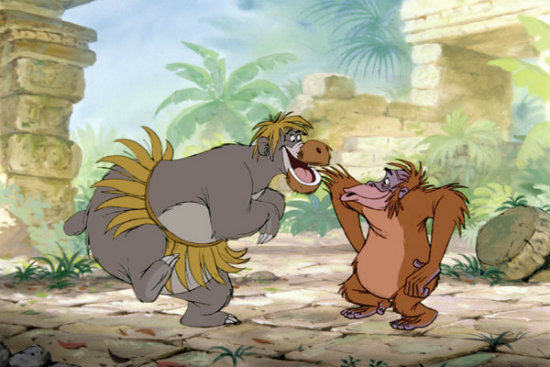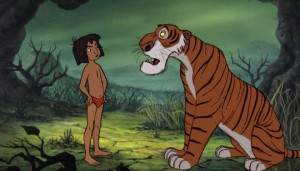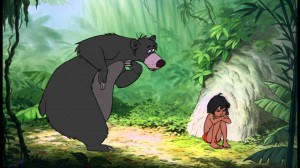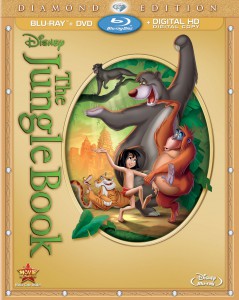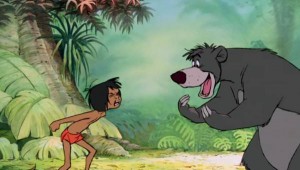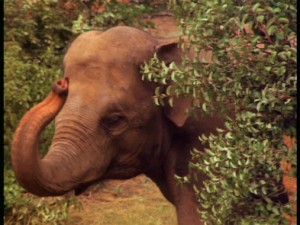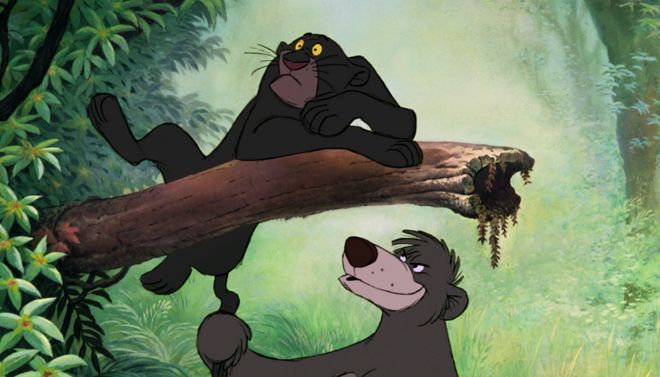The release of The Jungle Book on Blu-ray today has become, as when Saving Mr. Banks was unveiled a couple months ago, an unplanned forum on a most thorny issue for the Disney uber-fan: was Walt Disney a racist/sexist/anti-Semite, and if so, was he a super-racist/sexist/anti-Semite, or just your average, garden-variety racist/sexist/anti-Semite? Even though the 1967 animated film based loosely on a collection of stories by Rudyard Kipling opened months after Disney passed away, this was the last film on which he had any serious impact. And, since Meryl Streep chose to make her speech applauding Emma Thompson for her performance as P.L. Travers in Saving Mr. Banks as much about exactly how bad a man Walt Disney was, the issue of his true personal feelings–whatever those may have been–and whether or not they crept into the films he made has become unavoidable as of late. Though Streep’s comments didn’t utilize The Jungle Book as Exhibit A in the case of the People vs. Uncle Walt, her remarks provided a jumping-off point for Disney’s grandniece, Abigail, a few days later.
“Anti-Semite? Check. Misogynist? OF COURSE!! Racist? C’mon he made a film (Jungle Book) about how you should ‘stay with your own kind’ at the height of the fight over segregation! As if the ‘King of the Jungle’ number wasn’t proof enough!! How much more information do you need?” I quote these words verbatim from Ms. Disney’s Facebook page via The Hollywood Reporter, from about a month ago. We can safely presume that the “’King of the Jungle’” number she’s talking about is “I Wan’na Be Like You,” performed by Louis Prima, playing King Louie of the monkeys. (As a quick refresher, in this scene, King Louie longs for the ability to create and control fire, presuming that this skill will make he and his lackeys as human as Mowgli or any man.) Also, not many of us need to perform a ton of mental back flips to arrive at Ms. Disney’s thesis: that the movie argues in favor of Mowgli going back to live in the Man Village, as opposed to staying in the jungle with his animal friends Baloo and Bagheera. As such, it’s certainly possible to see The Jungle Book as a stealth racist screed arguing in favor of segregation.
However. (You knew that was coming.) I find it difficult to completely agree with Ms. Disney’s argument on that fundamental level. I will not argue, here or elsewhere, that Walt Disney was the exact opposite of a racist, sexist, or anti-Semite. (And, for context, I’m a straight white guy, so that may make my counterargument here shaky to those who would be more readily willing to accept Ms. Disney’s premise.) It would be the height of foolishness to say that Disney was a progressive filmmaker in the industry circa the 1960s, when plenty of evidence to the opposite exists, often within Disney’s animation. What I would take issue with is that, of all the many examples one could use to accurately or inaccurately paint Walt Disney as a racist, Ms. Disney specifically chose The Jungle Book. Arguably, by choosing to adapt a collection of stories by a well-known pro-colonialist writer, Disney was getting himself into trouble from the word go. Though this movie isn’t faithful to the letter to Kipling’s works, some of the broad strokes are there—a boy is raised by wolves in the jungle, then spends time with a friendly bear and panther, runs afoul of a tiger named Shere Khan, and eventually reenters the world of man. The “I Wan’na Be Like You” musical sequence, one of the film’s rhythmic high points, can be read in a way that supports Ms. Disney’s conclusion, if barely: one group wants to be seen as equal to Mowgli, presuming that fire will allow them to be more civilized than they currently are.
But I think you have to look for racism in The Jungle Book, and that you will find it only if you desperately want to. Regarding Ms. Disney’s overall point, I would not agree that her grand-uncle was a rabidly racist, sexist, or anti-Semitic figure in Hollywood; I would, however, not deny that he displayed casually bigoted tendencies that only further place him as a man of his time. I do not mean to excuse him for his creative mistakes in these capacities. If you want to argue that Walt Disney was a racist and wish to use his animated films as proof, that’s all well and good; using The Jungle Book as the prime example puts you on shaky ground. Ms. Disney’s comments implicitly damn Walt Disney as having been racist specifically to African Americans; while it’s true that a few of his films do depict African American characters poorly, it’s almost more troubling that we don’t have this discussion about some of Disney’s other animated features, and the depiction of other, non-white, non-African American characters. (I know we’re traveling down a tangent only slightly connected to The Jungle Book now. Bear with me.)
Why is it, for example, that so many people take more issue with Song of the South than with Peter Pan? (Please note: I am not attempting to ignore the fact that Song of the South is an immensely troubling film in its racial commentary.) One film’s racism targets African Americans, while another targets Native Americans. I realize that its defenders would argue that Peter Pan is a much different animal than Song of the South; it’s a fantasy, where Song of the South is set in the Reconstruction era. Certainly, both movies have fantastical elements, but the 1946 film about Uncle Remus and his stories is at least half set in a facsimile of reality. Technically, Tiger Lily and her father aren’t Native Americans, they’re Native Never Landers (or whatever). I can only say this much: I find it vastly more discomfiting that Peter Pan has been showered with a Diamond Edition Blu-ray from the Walt Disney Company, and Song of the South is treated, aside from being the inspiration for one of the most massively popular theme-park attractions in the world, as if it doesn’t exist. I’ve seen arguments online, or at least theories postulated, that racism against Native Americans is perceived as being, somehow, not as offensive as racism against African Americans. These people aren’t saying such a perception is accurate, of course, but that it’s merely possible. Perhaps because Peter Pan is more frequently lauded, its existence feels more and more like an embarrassment, as we watch so-called Indian characters explain to guileless young English children “what makes the red man red.”
My point, though, specific to Ms. Disney’s comments is that Walt Disney and many of his animators were less racists, and more products of the era in which they grew up. When we watch, say, episodes of Mad Men, we may be taken aback at the way in which the lead male characters treat their secretaries or the African American elevator operators, or simply women and African Americans in general. And it is shocking, because although racism and sexism haven’t been eradicated in the mid-21st century, these beliefs aren’t nearly as forceful or acceptable in the workplace. But they were in the 1960s. Casual bigotry from white men was an unfortunate and often despicable aspect of the so-called Greatest Generation. I realize, of course, that this doesn’t represent the best or most helpful defense to Walt Disney—“He wasn’t overtly racist/sexist/anti-Semitic! He was just…casually all of those things…because he didn’t know better”—but that doesn’t make it any less true. (I also realize that being an outsider who chooses to take issue with comments made by a member of Walt Disney’s extended family doesn’t place me on the surest of argumentative footing.) Disney did utilize stereotypes in his animation—a more overt and misbegotten choice is the flamboyant character Jim Crow in Dumbo, voiced by a white actor—but I’d argue he used them less because he harbored truly hateful feelings towards non-white men, but because he didn’t see these stereotypes as being damaging.
One more thought on racism in Disney animation: there are, as of now, 53 films in the Disney animated feature canon. Including the impending Blu-ray release for Frozen, only 11 of these features aren’t available on a Region A Blu-ray. (A few of these films, though, are on Blu-ray in other countries, such as the United Kingdom.) Six of these are the package films of the 1940s, which I imagine will one day find themselves in high-definition via various two-pack editions. The other five are as follows: One Hundred and One Dalmatians, The Black Cauldron, Aladdin, Hercules, and Tarzan. Of these five, I think only one of them not yet being on Blu-ray makes sense, and that’s The Black Cauldron, a film that represents the nadir of Disney animation, at least in terms of what its existence meant to the company at the time of its release. And frankly, considering the number of random anniversary-specific releases we’ve gotten in past years—the 30th Anniversary Blu-ray of The Fox and the Hound, say—it’s not unlikely that this film won’t find its way onto Blu-ray next year for its own 30th anniversary. The same could go for Tarzan, which celebrates its 15th anniversary this year. But I want to zero in on the most surprising no-show here: Aladdin. Here’s a film that was slated to be on Blu-ray a year ago, until it was tossed aside for the Peter Pan 60th anniversary release. (Being fair, a 60th anniversary release for Peter Pan makes more sense than a…21st anniversary release for Aladdin.) We are now in the age of Diamond Edition Blu-rays, but before that, we had Disney Platinum Edition DVDs, and Aladdin was among them. There were, in fact, 13 Platinum Editions, and as of the end of this year, there will be 10 Diamond Editions; the three outliers are Pinocchio (which is already on Blu-ray), One Hundred and One Dalmatians, and Aladdin. I haven’t the foggiest idea why One Hundred and One Dalmatians isn’t already on Blu-ray, let alone headed for one; however, I can’t help but wonder if the issue of racism hovers now over Aladdin like an unshakable rain cloud.
“Now, what the hell does this have to do with The Jungle Book being on Blu-ray?” I’m glad you asked! (It means you’re still reading. Good for you.) The comments I cited from Abigail Disney, I think, are impossible to ignore (or at least, I felt it would be wrong to do so), and to discuss them means you have to discuss the rest of Disney’s animated filmography, or at least the other possible moral offenders in the bunch. Controversy of a sort has marred Aladdin, for example, since its 1992 release. The opening song, “Arabian Nights,” originally had the following lyric, though it’s since been removed from CD and DVD re-releases: “Where they cut off your ear if they don’t like your face.” Others took issue with the Anglicized facial features of our leading characters, Aladdin and Jasmine, both of whom were also voiced by white people. Neither of these legitimate concerns were enough of an issue to ward off the 2004 2-disc DVD release, granted, but I wonder if it’s become too touchy of a subject for Disney to broach in 2014. What I fear is happening here, as has happened with the Song of the South debate, is that someone at Disney is essentially ranking—or is imagining that general audiences would do this—which type of racism is worse to modern society. Which are more damaging, stereotypes about African Americans or Native Americans? Or stereotypes about the Middle East? The thought, apparently, is that one of these is more acceptable, acceptable enough to merit a newer Blu-ray release. While I can understand and appreciate the corporate reasons for not wanting to incur more controversy, I think there’s a way for Disney to take a risk—yes, I know, this is a pipe dream—and try to at least begin the debate instead of being forcefully dragged into it. As awkward and misguided and downright painful as Song of the South, say, can be, to look at the film through a historical lens and discuss its problems in an even halfway-honest fashion would be an improvement on pretending it’s not real.
Also, frankly, this is a more worthwhile and fruitful discussion to have, even if it’s tangentially related to The Jungle Book’s Diamond Edition Blu-ray, because the Blu-ray itself isn’t that much to speak of, sadly. Here’s a problem I’ve discussed in past Blu-ray reviews of Disney catalog films: the previous DVD editions of so many of these movies went whole-hog with special features that there’s little the high-definition editions can, or choose to, improve upon. There are, if you are being exceedingly generous, eight new special features here: two minute-long introductions to the film, one from the late Diane Disney Miller and one from composer Richard Sherman; a sing-along track accessed two ways: by pausing the film, or by selecting the track from the special features page on the Blu-ray menu; an alternate ending; a 10-minute look at the current state of Disney’s Animation building; a 10-minute discussion between Sherman, Disney Miller, and animator Floyd Norman about the film itself; and a 20-minute feature highlighting how super-duper-amazing Disney’s Animal Kingdom park is (about which more later). The DVD’s special features—ten of them, including an audio commentary and a behind-the-scenes documentary—are all ported over to the Blu-ray, but as with past Blu-ray releases of older Disney animated canon entries, all that matters here is whether the movie looks good or not in high-definition.
For the most part, the answer is yes. The Jungle Book is the high point of the xerographic era at Walt Disney Animation Studios, extending all the way from One Hundred and One Dalmatians to The Fox and the Hound. The concept of xerography, thought up by tech wizard Ub Iwerks, essentially made the animation process easier on a shot-by-shot basis, but it also allowed Disney’s animators to take the easy way out. One of this film’s most beloved moments—in that “I Wan’na Be Like You” number where Baloo and King Louie dance with each other during the song’s climax—was basically traced over for a similar dance scene in Robin Hood just 6 years later. I bring up xerography specific to this film less to damn the animation and more to clarify why the HD transfer is accurate in porting over the imperfections in each shot. The hand-drawn animation of the Disney Renaissance is far cleaner than anything in The Jungle Book, a beautiful and colorful picture with characters whose lines and movements are all the more apparent because of the house style at the time. Director Wolfgang Reitherman (whose son Bruce plays Mowgli, sadly as kind of an obnoxious drip) clearly enjoyed a lack of cleanliness in the way his characters move or talk; all this is to say that The Jungle Book looks great in HD, but it also doesn’t look inappropriately cleaned up.
As I watched the film this time, of course, I had Ms. Disney’s comments in mind. In truth, attempting to see the film as she does, as a noxious commentary on the racial struggles of the period, made the experience a bit more entertaining, even if I ended up disagreeing with her thesis. The Jungle Book is an exceedingly episodic story, where Mowgli goes from one jungle-dweller to another, spends a little time with them, and then moves to the next one. It’s almost akin to speed-dating: five minutes with Bagheera here, five minutes with King Louie there, and so on. The pacing of the picture is in fits and starts; we don’t even meet Baloo for the first 20 minutes of its 78-minute length, and the oft-discussed Shere Khan only appears in the final half-hour. There’s little narrative drive in the film, even though the conflict is clearly stated almost immediately: as much as Mowgli loves having grown up in the jungle, he has to leave or else the tiger will kill him. Some aspects of the film are as impressive now (or more so) as when I first saw the movie as a child: George Bruns’ score, partly incorporating the songs by Richard and Robert Sherman, & Terry Gilksyon, is an excellent, low-key set of alluring compositions; both the “Bare Necessities” and “I Wan’na Be Like You” songs are endearing and toe-tapping inspirations for what would come during the Disney Renaissance; and Sebastian Cabot as Bagheera is a put-upon delight.
Much of the film, though, feels like a relic of the 1960s. Phil Harris, in arguably his best voice acting role, is fun as Baloo but his hepcat style of speaking is almost charmingly dated. I’d say the same of Louis Prima’s work, but seeing as he’s only in one sequence, it’s less bothersome. The most clearly era-specific scene, though, is one in which Mowgli encounters a quartet of vultures, most of whom appear to have come straight from Liverpool, England. Yes, these are the Beatles vultures, a strange phrase if ever I typed one. I won’t lie: I kind of like their “That’s What Friends Are For” song, partly for its incongruity. (These vultures seem totally uninterested in eating Mowgli, though I do wonder if the song was initially composed with a bit more menace intended.) Or maybe I’m just a sucker for the song’s kicker, in which Shere Khan pulls out his baritone to finish off the number. Still, as I watch The Jungle Book now, it’s, at best, a harmless trifle. Arguably, there are a few elements which lend a bit of credence to the pro-white, stiff-upper-lip British sensibility Rudyard Kipling was known for, specifically the elephant characters, the very same who are depicted as buffoonish know-nothings. But moving on from the film itself, let’s finish this column off with my favorite pet peeve in new Disney Blu-rays: the special features, or lack thereof.
Ah, those new special features. I can’t resist discussing them, even though it’s become clearer to me over the last few months from discussions on Twitter and Facebook and Letterboxd that a growing number of cinephiles care less about the supplements on a Blu-ray release, and more about the Blu-ray transfer itself. And I get that—the movie is almost always the primary reason to buy any Blu-ray. But Disney Blu-rays, especially, often feel understuffed considering how much you’re asked to pay for them; few movies are worth a retail price of 40 dollars (as I type this, The Jungle Book is available for preorder 23 dollars on Amazon, which is somewhat better). I want to—well, no, I don’t want to, but I have to—first discuss “I Wanna Be Like You,” the longest new special feature on the Blu-ray. Based on the title, you might presume it has something to do with the memorable, if possibly controversial, song performed by the aforementioned Louis Prima, or with the film’s music in general. And you would be wrong. (Sorry. No easy way to tell you.) As alluded to above, “I Wanna Be Like You” is all about Disney’s Animal Kingdom park at the Walt Disney World resort, and its total and complete awesomeness, and maybe you should think about booking that trip already, huh? To be clear, Disney’s Animal Kingdom is a pretty nice park, but this feature has just about nothing to do with The Jungle Book. There is the tenuous connection that parts of Disney’s Animal Kingdom are designed to represent the jungles of India; plus, our audience surrogates/actors comment on how a real-life tiger at Animal Kingdom looks just like Shere Khan, how about that! But otherwise, this is a promotional piece that serves no purpose on this Blu-ray.
The promotional aspect of the supplement is no more evident than when you consider the two lead characters, Blake and G. Blake and G, you see, are brother and sister and not in any way actors at all, how dare you even imply that. Of course, technically, I don’t know that these two aren’t brother and sister; I can only say that the way both of them acted (let alone the reality-TV-style editing and presentation) made me think they met each other for the first time mere minutes before the cameras were rolling. What fascinates me is this: I have no idea why Disney felt the need to make this feature and to include it on this Blu-ray. No doubt, the company will be raising the Animal Kingdom park’s profile in the years to come, as they begin construction on a land themed to James Cameron’s Avatar. (Remember Avatar?) But this feature focuses only on Disney’s work with animals, and while that’s a noble effort indeed, it’s something of a waste here. And unlike past Blu-ray features that highlighted changes to Walt Disney World’s Fantasyland section, this one places its focus on two Disney Channel castaways instead of Disney’s theme-park employees, letting them overact their way around real animal handlers and keepers who struggle with sticking to the obviously, painfully scripted lines.
What makes this feature stand out, again, is its length. The only other special features with any meat on them are still meager compared to this folderol. First, there’s the alternate ending, dubbed “Mowgli and the Hunter,” in which the man cub returns to the village, lives with his biological parents for a few months, and then is lured back into the jungle to take down Shere Khan and face off with a hunter who thinks he’s some kind of shaman. (This section, specifically, is heavily inspired by Kipling’s stories.) Of course, the finished film ends with Mowgli being lured back to civilization by a girl with pretty eyes and a siren song, and him not planning on going back. However, if you’ve ever seen The Jungle Book 2, first, let me say I’m sorry and I feel your pain. (If you haven’t seen this theatrically released 2003 sequel, here’s a word of advice: don’t.) For the lucky ones out there, here’s a quick summary of The Jungle Book 2: Mowgli has been adopted by the family of the girl with pretty eyes, Shanti, but is having difficulty assimilating back into society. One day, he can’t resist and heads back into the jungle, only to face off once more with Shere Khan, reunite with Baloo, run into King Louie’s monkeys again (though not King Louie himself), and more. Essentially, Mowgli reunites with everyone we saw in the first film, to ill effect. Watching this alternate ending play out via updated storyboards, it’s fascinating to see that this original take, which is probably too serious a capper for an otherwise laid-back and lighthearted film, would’ve been a darker and mercifully shorter take on many themes present in the sequel. The alternate ending, like many deleted scenes in home media releases, isn’t a necessity but is still an interesting look at what might have been. (And I wonder if it might’ve represented a counter to Ms. Disney’s comments, because in this version, Mowgli clearly doesn’t want to stay in the world of man, but rather in the jungle.)
Aside from the charmingly designed sing-along feature, called Bear-E-Oke (See, because it sounds like “karaoke,” get it? Get it?), there’s a new “@DisneyAnimation” supplement subtitled “Sparking Creativity.” In essence, it focuses on a program called Spark at Disney Animation, wherein animators and other staff members are encouraged to introduce and pitch new ideas and concepts to their fellow employees. Getting a quick look at the types of technologically forward-thinking ideas Disney’s animators are springing on their colleagues, such as a computer system that translates human movements into computer-animated special effects, is very exciting. It is, however, a bit baffling to see the notion of thinking ahead 5 or 10 years down the road introduced on a Blu-ray of a film that is decidedly old-fashioned in its style. (The xerographic era, as mentioned above, was in full swing in the mid-1960s, though many animators and historians on the DVD supplements praise, rightly, The Jungle Book’s character animation and design. Baloo and Mowgli, in particular, are excellently designed.) Moreover, I can’t help but long for a future where hand-drawn animation survives at Disney, as opposed to one where it’s utilized in part for an Oscar-winning short (Paperman, whose director John Kahrs is mentioned here briefly, in spite of him now working for Paramount Animation) and then only applied in the pre-production process for upcoming features. However, if you’re curious for even a slight morsel of how the animation studio operates, this is another worthy supplement, one that could and should have easily been twice as long.
Finally, there’s the “Music, Memories, & Mowgli” feature in which Diane Disney Miller, songwriter Richard Sherman, and Floyd Norman (an animator on The Jungle Book) discuss the film’s creation at the Walt Disney Family Museum before taking a peek at some unearthed artwork. Like the “@DisneyAnimation” supplement, this feature only barely comes close to 10 minutes in length, when it’s obvious that all three participants have tons of stories to tell about this production, which went through a well-known upheaval midway through. (Story man Bill Peet left the company after he and Walt butted heads over the direction the film should take; he favored a darker take than Disney did.) Watching the feature, it’s hard not to see the trio’s various reminiscences being coached along, if not outright staged. Many of their remembrances take the form of a story you recount with your friends or family members for the umpteenth time; all of you know where the story goes, so what matters more in the telling is remembering that you were there when the story occurred. Admittedly, it’s a little strange to watch this, or the introduction feature, and see Disney Miller, who passed away last November, without any direct acknowledgement of her loss. (I realize that the Blu-ray’s production schedule made it impossible to comment on her passing, though.) However, the level of respect afforded to her and other members of the old guard like Norman and Sherman is welcome, if only because it’s heartening to see such respect still exist in these home media releases.
The Jungle Book is, to my mind, an imperfect but charming piece of animation, the last solid film from Walt Disney Animation Studios before the Disney Renaissance kicked off in 1989 with The Little Mermaid. I’m not sure how many people will rewatch the film with Abigail Disney’s comments in mind, but I’m legitimately curious to read a more detailed argument clarifying the accusation that this film is racist. I say this less as a veiled way of revealing that I don’t see racist elements or overtones in other Disney animation—I very much do—and more that this specific film doesn’t fill me with distaste in the same way that, in certain moments or scenes, Dumbo or Peter Pan do. (To properly discuss the issues of sexism and/or anti-Semitism in Disney’s films would take, oh, I don’t know, about 10,000 more words, and would be separate from even the most tangential discussion of this film. One day, maybe.) It is, perhaps, an unconscious critique on my part of The Jungle Book that a wider, more expansive conversation about racial representation in Disney’s animated canon is a more interesting avenue to explore than this movie’s depreciation or lack thereof on Blu-ray. The Jungle Book, to me, is not the film that conversation should be centered around; it’s a well-animated, if far too episodic film with a meager smattering of new special features on Blu-ray. If you’re a fan or completist, you’ll want to buy it. If not, though, I’d only say it doesn’t deserve to be dismissed as quickly as Ms. Disney recently did.
— Josh Spiegel

